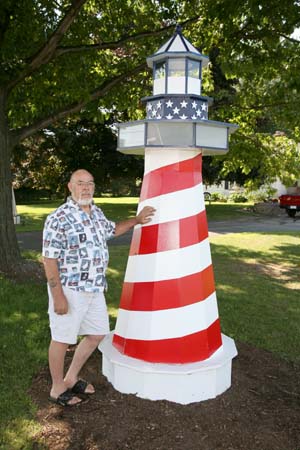
many shores From coast to coast - well almost - Dick Bausch's lighthouses grace front yards, overlook majestic rocky coasts, and keep guard over garden-scapes. Bausch, of Spencerport, began constructing lighthouses as a hobby about four years ago and, so far, his lighthouses can be found throughout the local area, in Alexandria Bay in the Thousand Islands, in Canada and as far away as California. "I'm a retired welder/fabricator and I was a mechanic, but I was looking to do something that would take me out of the grease and into the sawdust," he said. On a recent morning, Bausch sat in his garage workshop dressed in a shirt bearing lighthouse designs, sipping coffee, surrounded by his woodworking tools and walls of clocks he's recently begun designing. On the work table lay a cherry wood clock with intricate designs, soaking up a coat of stain. In the yard stood two lighthouses and a windmill. "I usually have one project or another going in various stages," he said. "I have two lighthouses available at any given time." Because of the price of the wood and the options he offers in sizes and colors of the finished lighthouses, he waits until an order has been placed to begin construction of the seashore symbols. "Since September 11, I have had a lot of requests for the patriotic lighthouses," he said. He typically paints these with red, white and blue designs. He pulled out a scrapbook that showed lighthouses painted in colors to match the paint and trim of a home, grays, reds, some with anchors carved into them, others with what looked like fencing around the area surrounding the light. "I made this," he said, pointing to a red and white lighthouse with tiny red crosses carved and painted red, "for a church to borrow. Their logo for their youth group is a red and white lighthouse, they took it to Massachusetts for a conference." The lighthouses range in size from six to 12 feet tall and come equipped with a dawn to dusk light. He crafts them from hand in a special plywood, paints them with several coats of paint. They can withstand the elements for up to 40 years. When asked why he chose to concentrate his skills on lighthouses, the former Navy man said, "I've always liked the water and I know a lot of people who collect lighthouses in other forms, such as salt and pepper shakers, so I thought, why not try to make a life size one." Bausch created the pattern for the lighthouses, which can be either six- or eight-sided, and puts them together with wooden pegs and glue rather than nails. While his lighthouses can be found far and wide, he doesn't specifically advertise. It's all word of mouth and people traveling by (on Route 104) and seeing them out front and stopping in, he said. Bausch has even gotten a lighthouse out to California. He told the story of having lost touch with his daughter when she was an infant and he and her mother divorced. "I looked for her but couldn't find her," he said. On January 1, 2005 he received a phone call from a woman who said she was his daughter, Beverlee. "It was 46 years from when I'd seen her last," he said. "We planned a reunion and we've been keeping in touch." Both Bausch and his daughter have made trips to each other's homes but it was his other daughter, Sherry, a truck driver from Arkansas, who saw to the delivery of the lighthouse to Beverlee. "The next time Sherry comes through I am giving her a lighthouse for her yard as well," he said. Travelers down Route 104 are sure to see his roadside display of lighthouses and Bausch invites people to stop by and visit or call him at 352-1370. Guiding lights According to www.thinkquest.org: In early times people set fires at the edge of the water to warn boats of dangerous rocks and shores. The Egyptians were the first people to build lighthouses to use light to guide ships. In Egypt in 283 the Egyptians completed the tallest lighthouse ever built. It guided ships for over 1,500 years and stood 900 feet tall. Lighthouses were also constructed by the Phoenicians, Greeks and the Romans. The early lighthouses used wick lamps as a source of light. In the olden times the light beam could only travel a few miles. In 1822 the first modern lighthouse lens was invented by a Frenchman named Augustin Fresnel. He found out how to increase the light by using prisms. In 1841 the Fresnel lens was installed for the first time in a lighthouse. Lighthouses warn sailors to straighten their position so their ships don't hit land or obstacles in the sea. They are built on harbors, islands, and beaches. They act as guideposts for ships at night or in a storm. The first lighthouse in England was the Eddystone Rock Lighthouse built on a steep rock in 1698. Since then three more have been built on that location. The first lighthouse in America was the Boston Lighthouse on Brewster Island in Boston Harbor. The lighthouse was first lit in 1716, but was destroyed during the Revolutionary War. In the past, the lighthouses were run by keepers. When fog came up, the lighthouse keepers warned ships by lighting the light, ringing bells every hour or shooting cannons. Today, there are fewer lighthouses and their lamps run automatically using electricity. July 30, 2006 |
